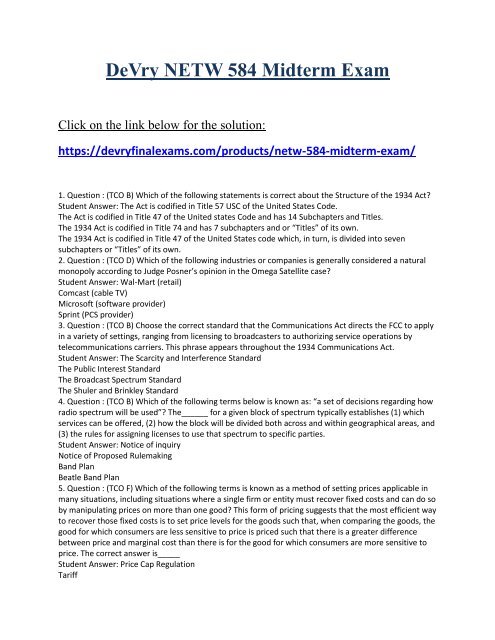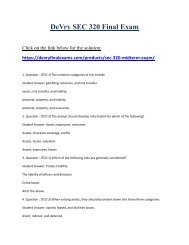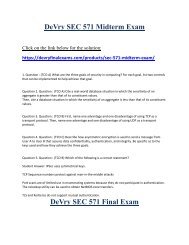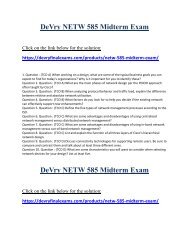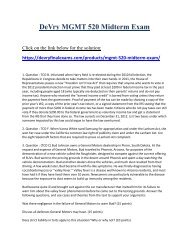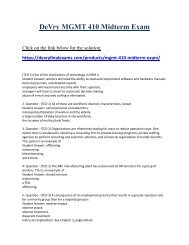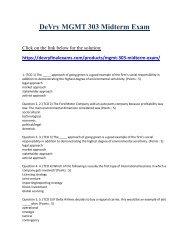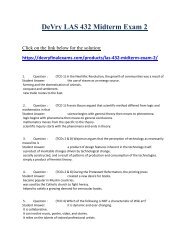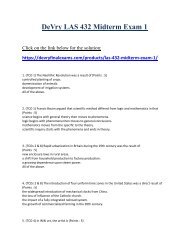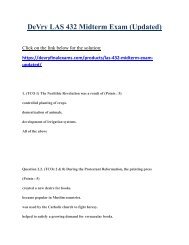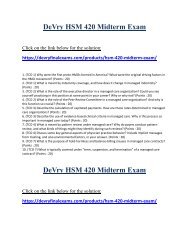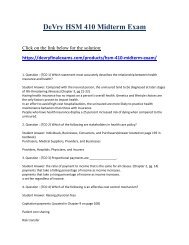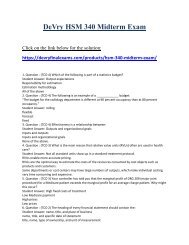NETW 584 Midterm Exam
Create successful ePaper yourself
Turn your PDF publications into a flip-book with our unique Google optimized e-Paper software.
DeVry <strong>NETW</strong> <strong>584</strong> <strong>Midterm</strong> <strong>Exam</strong><br />
Click on the link below for the solution:<br />
https://devryfinalexams.com/products/netw-<strong>584</strong>-midterm-exam/<br />
1. Question : (TCO B) Which of the following statements is correct about the Structure of the 1934 Act?<br />
Student Answer: The Act is codified in Title 57 USC of the United States Code.<br />
The Act is codified in Title 47 of the United states Code and has 14 Subchapters and Titles.<br />
The 1934 Act is codified in Title 74 and has 7 subchapters and or “Titles” of its own.<br />
The 1934 Act is codified in Title 47 of the United States code which, in turn, is divided into seven<br />
subchapters or “Titles” of its own.<br />
2. Question : (TCO D) Which of the following industries or companies is generally considered a natural<br />
monopoly according to Judge Posner’s opinion in the Omega Satellite case?<br />
Student Answer: Wal-Mart (retail)<br />
Comcast (cable TV)<br />
Microsoft (software provider)<br />
Sprint (PCS provider)<br />
3. Question : (TCO B) Choose the correct standard that the Communications Act directs the FCC to apply<br />
in a variety of settings, ranging from licensing to broadcasters to authorizing service operations by<br />
telecommunications carriers. This phrase appears throughout the 1934 Communications Act.<br />
Student Answer: The Scarcity and Interference Standard<br />
The Public Interest Standard<br />
The Broadcast Spectrum Standard<br />
The Shuler and Brinkley Standard<br />
4. Question : (TCO B) Which of the following terms below is known as: “a set of decisions regarding how<br />
radio spectrum will be used”? The______ for a given block of spectrum typically establishes (1) which<br />
services can be offered, (2) how the block will be divided both across and within geographical areas, and<br />
(3) the rules for assigning licenses to use that spectrum to specific parties.<br />
Student Answer: Notice of inquiry<br />
Notice of Proposed Rulemaking<br />
Band Plan<br />
Beatle Band Plan<br />
5. Question : (TCO F) Which of the following terms is known as a method of setting prices applicable in<br />
many situations, including situations where a single firm or entity must recover fixed costs and can do so<br />
by manipulating prices on more than one good? This form of pricing suggests that the most efficient way<br />
to recover those fixed costs is to set price levels for the goods such that, when comparing the goods, the<br />
good for which consumers are less sensitive to price is priced such that there is a greater difference<br />
between price and marginal cost than there is for the good for which consumers are more sensitive to<br />
price. The correct answer is_____<br />
Student Answer: Price Cap Regulation<br />
Tariff
Ramsey Pricing<br />
Rate-of Return Regulation<br />
Cream Skimming<br />
1. Question : (TCO A) Explain and discuss briefly the concept of why telecommunications technologies<br />
are to some degree substitutable.<br />
NOTE: Answer may be between 10 to 15 lines (or two paragraphs)<br />
2. Question : (TCO A) What section of the 1934 Act gives the Commission (FCC) the right to regulate the<br />
spectrum in a broad manner? What does it state?<br />
3. Question : (TCO C) Why did the 1985 Report and the 1987 Order seem to lump together all<br />
broadcasters and all markets? But wouldn’t the case for retention be stronger in some markets than in<br />
others? For instance, isn’t the case for retaining the fairness doctrine stronger for VHF television than<br />
AM or FM radio? What is the significance of the fact that the FCC did not draw such a distinction? Would<br />
it have been wiser to retain the fairness doctrine for certain markets? If so, how should such markets be<br />
identified and defined? Discuss.<br />
4. Question : (TCO C) Explain the concept, theories, and implications of a public trustee. In other words,<br />
what exactly is a public trustee in a broadcast sense? Do you agree with the concept of a public trustee<br />
in the telecommunications industry, why or why not?<br />
NOTE: Answer may be between 10 to 15 lines or more if you would like (or two paragraphs)<br />
5. Question : (TCO D) Evaluate the benefits and risks of Multichannel Video Programming Distribution<br />
(MVPD) regulation. Do you think there should be more or less regulation in the cable television market,<br />
why or why not?<br />
6. Question : (TCO E, F) The FCC generally seemed to regulate cable television with an eye toward<br />
protecting the pre-existing broadcast industry. Why did the FCC seem to favor broadcast? Discuss.<br />
7. Question : (TCO E, F) What was the fundamental problem of interconnection that involved Bell and<br />
the Independent Telephone Companies?<br />
DeVry <strong>NETW</strong> <strong>584</strong> <strong>Midterm</strong> <strong>Exam</strong><br />
Click on the link below for the solution:<br />
https://devryfinalexams.com/products/netw-<strong>584</strong>-midterm-exam/


